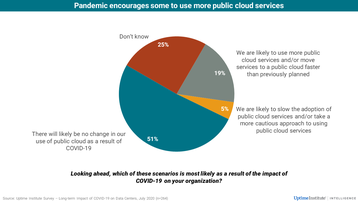As the Covid-19 pandemic has unfolded, many people have suggested that the business case for enterprises to move more workloads to the public cloud has been strengthened. Some have argued that the pandemic will accelerate the decline of the enterprise data center.
Is this actually the case? And if so, why? This is one of many issues explored in the recently published Uptime Institute report Post-pandemic data centers.
The case for an accelerated move to the public cloud may be summed up in one sentiment: Data centers were difficult enough to run even before the pandemic, and the costs, risks and complexity have all now increased. With the threat of new pandemics in future, it will be easier, even if it isn't cheaper, to move to the cloud.
There is some evidence that many enterprise operators are thinking along these lines — but it is not strong. In a July 2020 Uptime Institute survey of 260 operators, a fifth (19 percent) said they are likely to accelerate their move to a public cloud or use public cloud services more as a result of the pandemic. Just one in twenty (5 percent) thought the pandemic would slow their move to a public cloud. (Three-quarters said it would make no difference or that they did not know; see the figure).
What lies behind this? There are many reasons why the use of cloud services has increased or will increase as a result of Covid-19.
First, during the pandemic, many enterprises found they do not have the network infrastructure, or necessarily the applications, to support all their remotely situated staff and all their customer interactions on their networks. As a result, they have rapidly adopted or stepped up their use of cloud and other third-party services. Enterprise use of cloud platform providers (Amazon Web Services, Microsoft Azure, Google Cloud Platform) and of software as a service (Salesforce, Zoom, Teams) has significantly increased in the space of a few months.
Second, many operators foresee that the loss of an entire site due to staffing issues is a possibility in the future — and they are planning for this with a range of strategies, including more remote working, greater resiliency and more automation.
The pandemic will also likely increase the use of distributed, active-active-active availability zone approaches. Building and managing the IT infrastructure for this is always challenging and expensive. One of the “easier” ways, for many applications and services, is to make use of existing infrastructure run by cloud providers, their software infrastructure partners, and some colocation companies.
In spite of all this, it would be simplistic to state that the pandemic will trigger a significantly accelerated decline in enterprise data centers or increase in the migration of existing workloads. One of the reasons for cloud adoption, and certainly for the use of software as a service, is to enable relatively easy adoption of new services, such as teleconferencing. Few organizations have, in recent years, contemplated hosting such services in their own data centers.
The role of the pandemic as a catalyst of change, or an accelerator, has to be put in context. There is already a strong disposition among business and organizational leaders to make more use of the cloud. But migration can be a difficult process, involving re-platforming or rewriting applications, changing security and compliance processes, and foregoing corporate control for limited transparency. Uptime Institute’s research shows the balance of workloads shifting gradually, over time, in a cautious fashion.
A further issue: Chief Information Officers are facing cost constraints, with a global slowdown (if not recession) already underway. Cloud adoption usually involves a short-term spending increase, even if costs fall over time (which, depending on scale, they may not).
So, what is the takeaway? Public cloud adoption by enterprise is a strong trend with multiple adoption drivers. The pandemic will add to the rationale but will not make a decisive difference.





